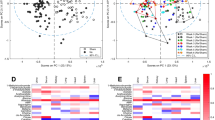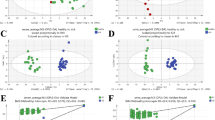Abstract
Acute kidney injury (AKI) is one of the main complications in acute care medicine and a risk factor for chronic kidney disease (CKD). AKI incidence has increased; however, its diagnosis has limitations and physiopathological mechanisms are underexplored. We investigated urine samples, aiming to identify major metabolite changes during human AKI evolution. Metabolic signatures found were further explored for a potential link to severity of injury. Twenty-four control subjects and 38 hospitalized patients with AKI were recruited and urine samples were collected at the time of diagnosis, during follow-up and at discharge. Nuclear magnetic resonance (NMR) was used in a first discovery phase for identifying potential metabolic differences. Target metabolites of interest were confirmed by liquid chromatography-mass spectrometry (LC-MS/MS) in an independent group. Underlying metabolic defects were further explored by kidney transcriptomics of murine toxic AKI. Urinary 2-hydroxybutyric acid, pantothenic acid, and hippuric acid were significantly downregulated and urinary N-acetylneuraminic acid, phosphoethanolamine, and serine were upregulated during AKI. Hippuric acid, phosphoethanolamine, and serine showed further downregulation/upregulation depending on the metabolite in acute tubular necrosis (ATN) AKI compared to prerenal AKI. Kidney transcriptomics disclosed decreased expression of cystathionase, cystathionine-β-synthase, and ethanolamine-phosphate cytidylyltransferase, and increased N-acetylneuraminate synthase as the potentially underlying cause of changes in urinary metabolites. A urinary metabolite panel identified AKI patients and provided insight into intrarenal events. A urine fingerprint made up of six metabolites may be related to pathophysiological changes in oxidative stress, energy generation, and H2S availability associated with AKI.
Key messages
-
The urinary metabolome reflects AKI evolution and severity of injury.
-
Kidney transcriptomics revealed enzymatic expression changes.
-
Enzymatic expression changes may be the potentially underlying cause of changes in urine metabolites.
-
Identified metabolite changes link oxidative stress, energy generation, and H2S availability to AKI.



Similar content being viewed by others
References
Lameire NH, Bagga A, Cruz D, De MJ, Endre Z, Kellum JA, Liu KD, Mehta RL, Pannu N, Van BW, Vanholder R (2013) Acute kidney injury: an increasing global concern. Lancet 382:170–179
Nash K, Hafeez A, Hou S (2002) Hospital-acquired renal insufficiency. Am J Kidney Dis 39:930–936
Ryden L, Sartipy U, Evans M, Holzmann MJ (2014) Acute kidney injury after coronary artery bypass grafting and long-term risk of end-stage renal disease. Circulation 130:2005–2011
Rewa O, Bagshaw SM (2014) Acute kidney injury-epidemiology, outcomes and economics. Nat Rev Nephrol 10:193–207
Goldberg R, Dennen P (2008) Long-term outcomes of acute kidney injury. Adv Chronic Kidney Dis 15:297–307
Coca SG, Yusuf B, Shlipak MG, Garg AX, Parikh CR (2009) Long-term risk of mortality and other adverse outcomes after acute kidney injury: a systematic review and meta-analysis. Am J Kidney Dis 53:961–973
(2012) KDIGO Clinical Practice Guideline for Acute Kidney Injury. Section 1: Introduction and Methodology. Kidney Int. Suppl (2011. ) 2:13–18
Ronco C, Kellum JA, Haase M (2012) Subclinical AKI is still AKI. Crit Care 16:313
Gobe GC, Coombes JS, Fassett RG, Endre ZH (2015) Biomarkers of drug-induced acute kidney injury in the adult. Expert Opin Drug Metab Toxicol 11:1683–1694
Gonzalez-Calero L, Martin-Lorenzo M, Ramos-Barron A, Ruiz-Criado J, Maroto AS, Ortiz A, Gomez-Alamillo C, Arias M, Vivanco F, Alvarez-Llamas G (2016) Urinary kininogen-1 and retinol binding protein-4 respond to acute kidney injury: predictors of patient prognosis? Sci Rep 6:19667
Nicholson JK, Lindon JC, Holmes E (1999) ‘Metabonomics’: understanding the metabolic responses of living systems to pathophysiological stimuli via multivariate statistical analysis of biological NMR spectroscopic data. Xenobiotica 29:1181–1189
Capati A, Ijare OB, Bezabeh T (2017) Diagnostic applications of nuclear magnetic resonance-based urinary metabolomics. Magn Reson Insights 10:1178623X17694346
Hocher B, Adamski J (2017) Metabolomics for clinical use and research in chronic kidney disease. Nat Rev Nephrol 13:269–284
(2012) KDIGO Clinical Practice Guideline for Acute Kidney Injury. Section 2: AKI Definition. Kidney Int. Suppl (2011. ) 2:19–36
Perazella MA, Coca SG (2012) Traditional urinary biomarkers in the assessment of hospital-acquired AKI. Clin J Am Soc Nephrol 7:167–174
(2012) Kidney Disease: Improving Global Outcomes (KDIGO) Acute Kidney Injury Work Group. KDIGO Clinical Practice Guideline for Acute Kidney Injury, In: 2 Ed., pp. 1–138
Gonzalez-Calero L, Martin-Lorenzo M, Martinez PJ, Baldan-Martin M, Ruiz-Hurtado G, Segura J, de la Cuesta F, Barderas MG, Ruilope LM, Vivanco F, Alvarez-Llamas G (2016) Hypertensive patients exhibit an altered metabolism. A specific metabolite signature in urine is able to predict albuminuria progression. Transl Res 178:25–37
Martin-Lorenzo M, Gonzalez-Calero L, Maroto AS, Martinez PJ, Zubiri I, de la Cuesta F, Mourino-Alvarez L, Barderas MG, Heredero A, Aldamiz-Echevarria G et al (2016) Cytoskeleton deregulation and impairment in amino acids and energy metabolism in early atherosclerosis at aortic tissue with reflection in plasma. Biochim Biophys Acta 1862:725–732
Martin-Lorenzo M, Zubiri I, Maroto AS, Gonzalez-Calero L, Posada-Ayala M, de la Cuesta F, Mourino-Alvarez L, Lopez-Almodovar LF, Calvo-Bonacho E, Ruilope LM et al (2015) KLK1 and ZG16B proteins and arginine-proline metabolism identified as novel targets to monitor atherosclerosis, acute coronary syndrome and recovery. Metabolomics 11:1056–1067
Posada-Ayala M, Zubiri I, Martin-Lorenzo M, Sanz-Maroto A, Molero D, Gonzalez-Calero L, Fernandez-Fernandez B, de la Cuesta F, Laborde CM, Barderas MG et al (2014) Identification of a urine metabolomic signature in patients with advanced-stage chronic kidney disease. Kidney Int 85:103–111
Tulpan D, Leger S, Belliveau L, Culf A, Cuperlovic-Culf M (2011) MetaboHunter: an automatic approach for identification of metabolites from 1H-NMR spectra of complex mixtures. BMC Bioinformatics 12:400
Sanz AB, Sanchez-Nino MD, Izquierdo MC, Jakubowski A, Justo P, Blanco-Colio LM, Ruiz-Ortega M, Selgas R, Egido J, Ortiz A (2010) TWEAK activates the non-canonical NFkappaB pathway in murine renal tubular cells: modulation of CCL21. PLoS One 5:e8955
Izquierdo MC, Sanz AB, Mezzano S, Blanco J, Carrasco S, Sanchez-Nino MD, Benito-Martin A, Ruiz-Ortega M, Egido J, Ortiz A (2012) TWEAK (tumor necrosis factor-like weak inducer of apoptosis) activates CXCL16 expression during renal tubulointerstitial inflammation. Kidney Int 81:1098–1107
Xia J, Sinelnikov IV, Han B, Wishart DS (2015) MetaboAnalyst 3.0—making metabolomics more meaningful. Nucleic Acids Res 43:W251–W257
Rifai N, Gillette MA, Carr SA (2006) Protein biomarker discovery and validation: the long and uncertain path to clinical utility. Nat Biotechnol 24:971–983
Dugbartey GJ, Talaei F, Houwertjes MC, Goris M, Epema AH, Bouma HR, Henning RH (2015) Dopamine treatment attenuates acute kidney injury in a rat model of deep hypothermia and rewarming—the role of renal H2S-producing enzymes. Eur J Pharmacol 769:225–233
Han SJ, Kim JI, Park JW, Park KM (2015) Hydrogen sulfide accelerates the recovery of kidney tubules after renal ischemia/reperfusion injury. Nephrol Dial Transplant 30:1497–1506
Aminzadeh MA, Vaziri ND (2012) Downregulation of the renal and hepatic hydrogen sulfide (H2S)-producing enzymes and capacity in chronic kidney disease. Nephrol Dial Transplant 27:498–504
Wei T, Tian W, Liu F, Xie G (2014) Protective effects of exogenous beta-hydroxybutyrate on paraquat toxicity in rat kidney. Biochem Biophys Res Commun 447:666–671
Tran MT, Zsengeller ZK, Berg AH, Khankin EV, Bhasin MK, Kim W, Clish CB, Stillman IE, Karumanchi SA, Rhee EP, Parikh SM (2016) PGC1alpha drives NAD biosynthesis linking oxidative metabolism to renal protection. Nature 531:528–532
Ruiz-Andres O, Suarez-Alvarez B, Sanchez-Ramos C, Monsalve M, Sanchez-Nino MD, Ruiz-Ortega M, Egido J, Ortiz A, Sanz AB (2016) The inflammatory cytokine TWEAK decreases PGC-1alpha expression and mitochondrial function in acute kidney injury. Kidney Int 89:399–410
Ruiz-Andres O, Sanchez-Nino MD, Moreno JA, Ruiz-Ortega M, Ramos AM, Sanz AB, Ortiz A (2016) Downregulation of kidney expression of protective factors by renal and systemic inflammation: role of transcription factors and epigenetic mechanisms. Am J Physiol Renal Physiol:ajprenal
Ozdemir R, Demirtas G, Parlakpinar H, Polat A, Tanbag K, Taslidere E, Karadag A (2016) Dexpanthenol therapy reduces lung damage in a hyperoxic lung injury in neonatal rats. J Matern Fetal Neonatal Med 29:1801–1807
Depeint F, Bruce WR, Shangari N, Mehta R, O'Brien PJ (2006) Mitochondrial function and toxicity: role of the B vitamin family on mitochondrial energy metabolism. Chem Biol Interact 163:94–112
Zhao YY, Lint RC (2014) Metabolomics in nephrotoxicity. Adv Clin Chem 65:69–89
Kishi S, Campanholle G, Gohil VM, Perocchi F, Brooks CR, Morizane R, Sabbisetti V, Ichimura T, Mootha VK, Bonventre JV (2015) Meclizine preconditioning protects the kidney against ischemia-reperfusion injury. EBioMedicine 2:1090–1101
Seppala R, Renlund M, Bernardini I, Tietze F, Gahl WA (1990) Renal handling of free sialic acid in normal humans and patients with Salla disease or renal disease. Lab Investig 63:197–203
K P, Kumar JA, Rai S, Shetty SK, Rai T, Shrinidhi, Begum M, Md S (2013) Predictive value of serum sialic acid in type-2 diabetes mellitus and its complication (nephropathy). J Clin Diagn Res 7:2435–2437
Racine SX, Le TP, Adnet F, Cohen Y, Cupa M, Hantz E, Le ML (2004) N-acetyl functions and acetate detected by nuclear magnetic resonance spectroscopy of urine to detect renal dysfunction following aminoglycoside and/or glycopeptide antibiotic therapy. Nephron Physiol 97:53–57
Boudonck KJ, Mitchell MW, Nemet L, Keresztes L, Nyska A, Shinar D, Rosenstock M (2009) Discovery of metabolomics biomarkers for early detection of nephrotoxicity. Toxicol Pathol 37:280–292
Klawitter J, Haschke M, Kahle C, Dingmann C, Klawitter J, Leibfritz D, Christians U (2010) Toxicodynamic effects of ciclosporin are reflected by metabolite profiles in the urine of healthy individuals after a single dose. Br J Clin Pharmacol 70:241–251
Bairaktari E, Seferiadis K, Liamis G, Psihogios N, Tsolas O, Elisaf M (2002) Rhabdomyolysis-related renal tubular damage studied by proton nuclear magnetic resonance spectroscopy of urine. Clin Chem 48:1106–1109
van der Kloet FM, Tempels FW, Ismail N, van der Heijden R, Kasper PT, Rojas-Cherto M, van DR, Spijksma G, Koek M, van der Greef J et al (2012) Discovery of early-stage biomarkers for diabetic kidney disease using ms-based metabolomics (FinnDiane study). Metabolomics 8:109–119
Zhang ZH, Wei F, Vaziri ND, Cheng XL, Bai X, Lin RC, Zhao YY (2015) Metabolomics insights into chronic kidney disease and modulatory effect of rhubarb against tubulointerstitial fibrosis. Sci Rep 5:14472
Acknowledgements
The authors thank Dolores Molero from CAI-RMN, UCM, Consuelo Agüeros from Nephrology Investigation Unit, and Servicio de Nefrología del Hospital Valdecilla. This work was supported by the Instituto de Salud Carlos III cosupported by FEDER grants [PI10/00624, PI13/01873, PI14/01650, PI15/00298, PI016/02057, PI16/01334, IF08/3667-1, CP09/00229, CPII15/00027, CP14/00133, PT13/0001/0013, intensificacion to AO, and REDinREN (RD12/0021/0001 and RD16/0009)], Fundación SENEFRO, and Fundación Conchita Rábago de Jiménez Díaz.
Author information
Authors and Affiliations
Corresponding author
Ethics declarations
Disclosure
The authors declare they have nothing to disclose.
Electronic supplementary material
ESM 1
(PDF 4110 kb)
Rights and permissions
About this article
Cite this article
Martin-Lorenzo, M., Gonzalez-Calero, L., Ramos-Barron, A. et al. Urine metabolomics insight into acute kidney injury point to oxidative stress disruptions in energy generation and H2S availability. J Mol Med 95, 1399–1409 (2017). https://doi.org/10.1007/s00109-017-1594-5
Received:
Revised:
Accepted:
Published:
Issue Date:
DOI: https://doi.org/10.1007/s00109-017-1594-5




